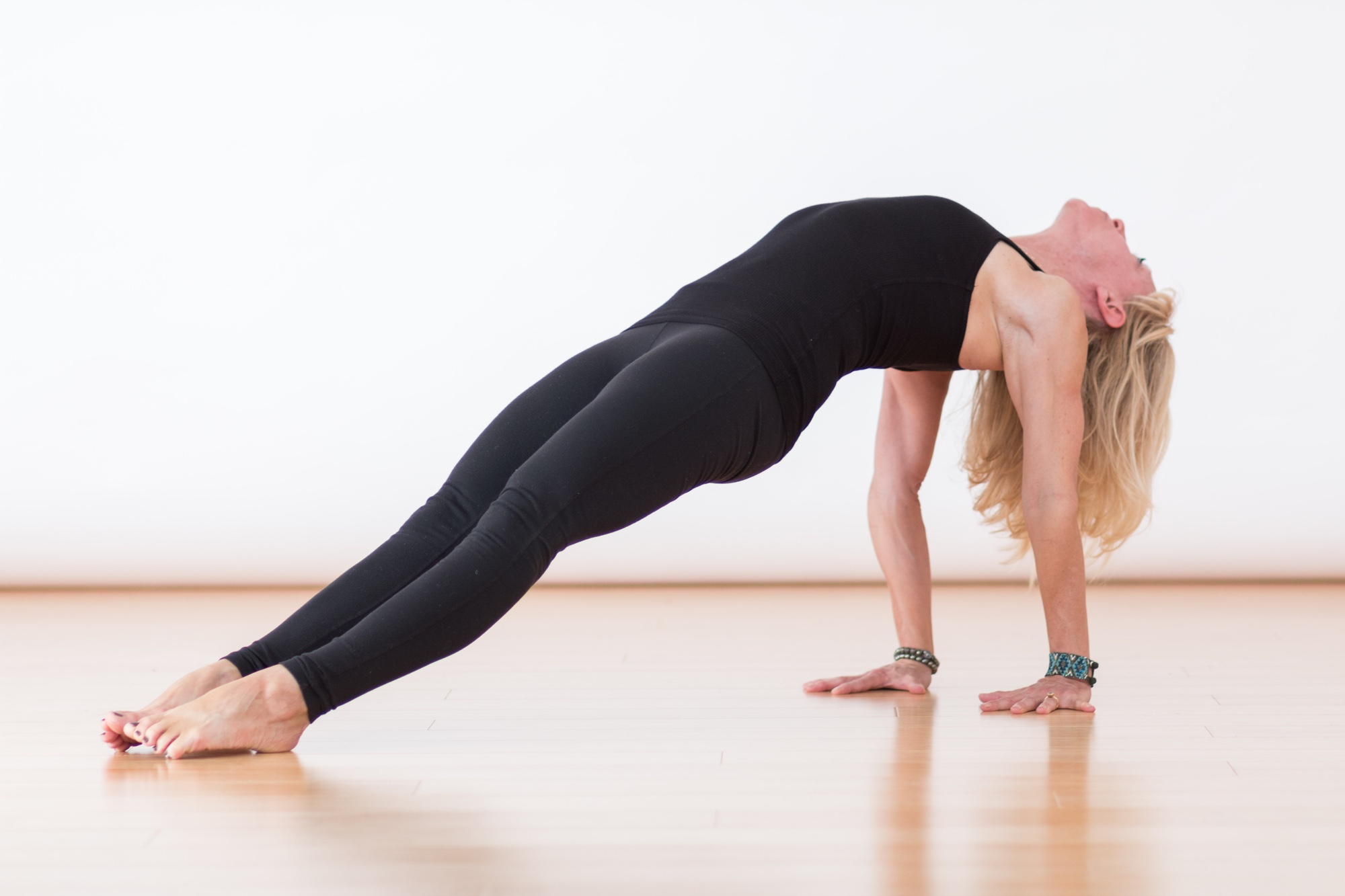PURVOTTANASANA
(poor-voh-tan-AHS-anna
purvottana = intense stretch of the East (purva = east; uttana = intense stretch)
Stretch-of-the-East Pose. According to hatha yoga, the human body is a miniature representation of the world at large. The four “quarters” of the body, the front, back, head, and feet, are analogized with the four compass points. The front body then stands for the east (purva), the quarter of the rising sun; conversely, the back body stands for the west (pashcima), where the sun sets. So we have two complementary poses, Purvottanasana and Pashcimottanasa.
1. Sit in Staff Pose (dandasana) with your hands positioned on the floor slightly behind your pelvis, fingers pointing forward, toward your feet. Bend your knees and put your feet on the floor, slightly pigeon-toed, about a foot away from your buttocks.
2. Inhale and lift your buttocks off the floor into a kind of “table” position. Your arms and forelegs will be more or less perpendicular to the floor, your torso and thighs parallel. For the time being keep your head in a neutral position, with your neck neither flexed nor extended. “Sharpen” your tail bone against the pelvis and “lengthen” it toward the knees as you roll your thighs inward. Firm your shoulder blades against your back, and press your inner hands actively into the floor.
3. With an inhale stretch one leg forward and press the sole to the floor. Do the same with the other leg. If, when you reach out the legs, you lose the sharpness and length of the tail bone, it’s likely you’ll not be able to bring the soles fully and firm to the floor. So be sure to keep the tail sharp and long. Turn the toes slightly inward, press the inner feet firmly against the floor, and keep your thighs active. Hold your torso parallel to the floor by firming the shoulder blades against the back.
4. You can keep your head in a neutral position. However, if your chest is open and your shoulder blades can descend actively toward your tail bone, you can drop your head back and extend the neck. Be careful though: the base of the skull shouldn’t jam against the nape.
5. Hold this position for 30 seconds to a minute, breathing as softly as possible. Then release the buttocks to the floor with an exhale.
- Benefits
Strengthens the arms and wrists, and the entire back of the body
Stretches the entire front of the body
Stretches the front ankles
- Contraindications: Avoid this pose if you have any shoulder or wrist injuries. If you have a neck injury, perform the pose a few inches away from a wall. Use the wall to support the back of your head to keep it in a neutral position (i.e., so the neck is neither flexed nor extended).
- Modifications & Props: If you have some difficulty performing this pose on the floor, you can instead use a metal chair (be sure its four “feet” are standing securely on a sticky mat). Sit near the front edge of the seat, knees bent at right angles, feet on the floor. With your hands grip the back edge of the seat. Then with an inhale, lift your pelvis off the seat. You can keep your knees bent or straighten them, turning the big toes slightly inward and pressing the inner feet firmly against the floor.
- Variations: This pose is usually described with the hands turned forward, pointing toward the feet. You can also perform Purvottanasana with your hands turned back, pointing away from the feet.
- Beginners Tip: It might be difficult for some beginners to get their feet flat on the floor. Estimate where your feet will touch the floor in the full pose, and position a sand bag so that once in the pose it will support the balls of your feet.
- Advanced Tip: To intensify the work of this pose, inhale and lift your right foot off the floor and bring the leg parallel to the floor. Hold for 10 to 15 seconds. Release with an exhale, then repeat with the left leg for the same length of time.
Video Links:
https://youtu.be/dlc6xCPx60U
https://youtu.be/NwFiWCUkk4M
https://youtu.be/Z5WGEMSdJ_s

